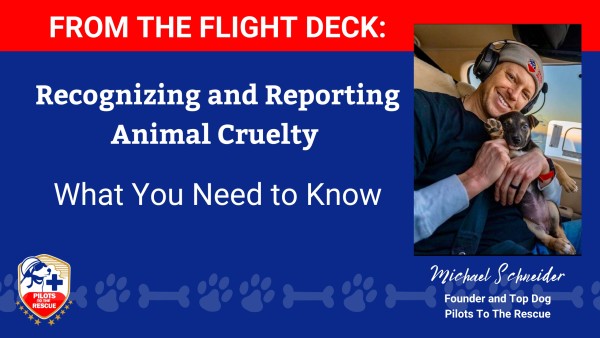Recognizing and Reporting Animal Cruelty: What You Need to Know
April is Prevention of Animal Cruelty Month, a nationwide observance dedicated to raising awareness about the mistreatment of animals and encouraging people to take action.
Reflecting on the ten years since I founded Pilots To The Rescue, I always knew animal cruelty was a significant problem in our country. However, witnessing firsthand the unimaginable suffering endured by innocent cats and dogs at the hands of humans truly revealed the immense scale of this daily tragedy. Both intentional animal cruelty and neglect have profoundly impacted me, strengthening my commitment to helping as many animals as possible.
One animal rescued by Pilots To The Rescue stands out in my mind. Arizona was a cat who lost a leg due to a gunshot wound, but found a second chance at life. Found as a stray in rural South Carolina with a shattered leg from a suspected gunshot, Arizona faced long odds. After surgery to amputate the injured limb, he joined Pilots to the Rescue’s April 10 flight to safety at Cat Tales in Seabrook, New Hampshire, Arizona is on his way to a loving forever home.
Any form of animal cruelty is a serious issue that demands our attention and action. Below is some information that I hope you will share with others.
Together, we can make a difference for animals.
What Does Animal Cruelty Look Like?
-
Intentional Harm: Physical abuse, poisoning, mutilation, or killing.
-
Neglect: Failure to provide basic needs such as food, water, shelter, and veterinary care. This can lead to emaciation, illness, and preventable suffering.
-
Abandonment: Leaving an animal to fend for itself, often in dangerous or unsuitable environments.
-
Animal Fighting: Organizing or participating in events where animals are forced to fight for entertainment.
-
Hoarding: Accumulating a large number of animals without the resources to provide adequate care.
Sometimes, the signs are obvious – visible wounds, extreme thinness, or an animal left tied outside in harsh weather without shelter. Other times, the signs might be more subtle, such as a consistently fearful or withdrawn animal, or unsanitary living conditions.
You Can Be Their Voice: What to Do If You Suspect Animal Cruelty
Witnessing or suspecting animal cruelty can be distressing, but your intervention could save an animal's life. Here's what the average person can do:
2. Report It: Don't assume someone else will take care of it. Your report can be the crucial first step in getting help for the animal. Here are the agencies you can contact:
-
Local Animal Control: This is often the first point of contact for animal welfare concerns. You can usually find their number online or through your local police department.
- Local Police Department or Sheriff's Office: They handle criminal matters and can investigate animal cruelty cases.
- Humane Society or SPCA: Many areas have local branches of these organizations that investigate animal cruelty and neglect. You can find your local chapter online.
- State or County Animal Welfare Agencies: Some states and counties have dedicated animal welfare departments.
3. Provide Specific Details: When you make a report, be as detailed as possible with the information you've gathered. Include the address where the cruelty is occurring, descriptions of the animals involved, and the specific acts you witnessed or suspect.
4. Follow Up (If Possible and Appropriate): Depending on the agency you contacted, you may be able to follow up on the status of your report. However, be mindful that investigations can take time, and details may not be shared due to confidentiality.
5. Support Local Shelters and Rescues: Even if you don't directly witness cruelty, you can make a difference by supporting your local animal shelters and rescue organizations. They are on the front lines, providing care and finding homes for animals in need. You can donate, volunteer your time, or even consider fostering or adopting.
Silence can be deadly for animals suffering in silence. By being vigilant and knowing how to report suspected cruelty, each of us can play a vital role in protecting vulnerable animals and creating a more humane world for all.




 Request A Rescue
Request A Rescue